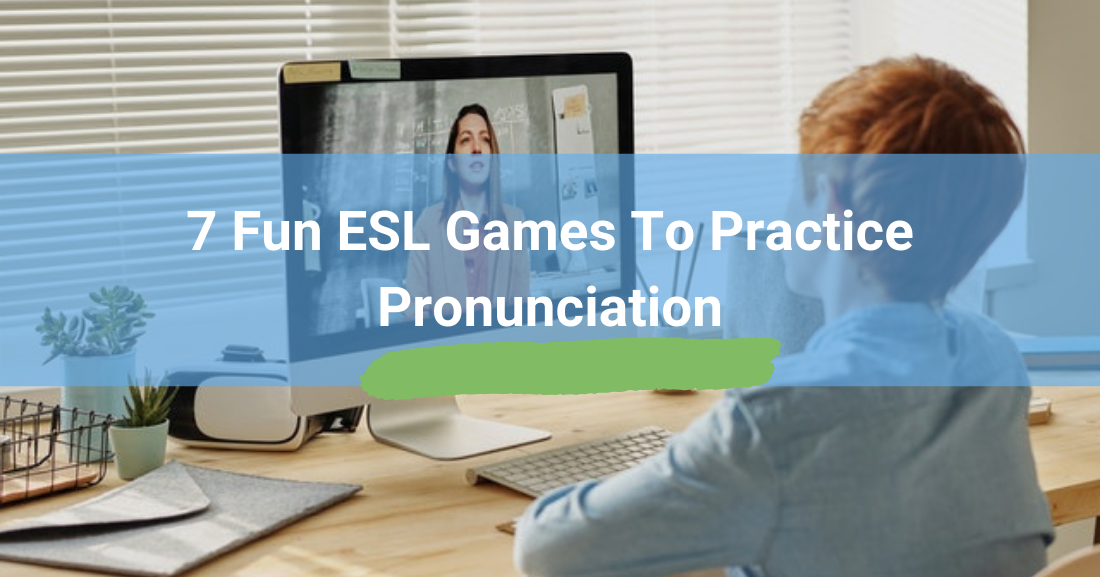7 Fun ESL Games to Practice Pronunciation


That doesn’t mean, however, that language learning comes without work. But “work” can sometimes mean losing the attention of your students to daydreams or other fancies. Here are some ways you can help your students practice pronunciation while still keeping things fun and holding their attention, especially if you teach elementary ESL.

Tongue twisters are fun for just about anyone, and the fact that they are universally challenging makes ESL students less frustrated about making mistakes. Put their pronunciation to the challenge, then, with some fun tongue twisters. You can find over five hundred English tongue twisters here. Choose some according to the pronunciation challenges of your students, or just pick the ones that you think your students will enjoy. If you like, have a tongue twister “bee”. Instead of giving students words to spell, hand them a slip of paper with a tongue twister on it. If they pronounce it correctly, they stay in the competition. If they make a mistake, they pass the tongue twister to the next person and sit out the rest of the competition.
If you are teaching syllabification and stress, this simple dice game might be right for you. Give your students a list of words you have previously broken down into syllables and identified where the stress goes. The list should contain words with one, two, and three syllables. On the list, though, do not put any markings for stress or syllables. Using a blank die or spinner, label the spaces 1, 2, and 3. You can play the game with your entire class or in groups of three to four students. To play the game, a student rolls the die. If she rolls a 1, she must read a word from the list that stresses the first syllable. If she rolls a 2, she must read a word from the list which stresses the second syllable, and so on. The other players listen to see if she has made a correct choice. If she chooses correctly, she scores one point. The first player to reach five points wins the game.
This game is fun whether you are practicing general pronunciation skills or a specific set of challenging sounds. Take several notecards and write the words you want your students to pronounce. About eighteen cards is a good number. Then add two or three cards that just say Bang! Put all the cards in an empty container and you are ready to play. Students take turns pulling a card from the container and reading the word on that card. If they pronounce it correctly, they get to keep it. If they make a mistake, the card goes back in the container. If they pull a Bang! card, all their cards go back into the can. Play until time is up. Whoever has the most cards in their possession at that time wins the game.
If you teach very young students (ages three to six or thereabouts), you are probably familiar with coloring pages for dot markers. (If you don’t already have a collection in your class resources, simply do an image search for dot marker pages or try one of these.) You can use these easy coloring pages as motivation for your students on their pronunciation journey. If you can, work one on one with your students. But if that isn’t possible or practical, have students work with a partner. Give your class a list of words to say that work on a specific pronunciation skill. Also, give each pair a dot marker and each student a dot marker sheet, such as a shark. Students take turns reading the words on your list. If they pronounce them correctly, they get to fill in a dot in the shark’s belly. Race to see how quickly your students can fill their sharks’ bellies.
Part of getting students to pronounce words correctly is getting them to hear words correctly. This can be especially challenging with certain sound pairs. For example, native Spanish speakers have a tough time distinguishing between long and short i (as in pine and pin) while native Japanese speakers have difficulty distinguishing between l and r. To test how well your students are hearing what you are saying, try this listening exercise. On a piece of paper, create a fishy flow chart. Draw a small fish on one side of your page, and in it write a minimal pair using the sounds your students need to work on (such as pine and pin). Draw two wavy lines from that fish to two other fish. Students will choose either the top or bottom fish depending on what they think they hear. In those fish, write another minimal pair (such as seedy and city). Write the same pair in each fish. Then write two waves going from each of those fish to two more. Students will have four fish to choose from this time, depending on which fish they started with and what word they think they heard in the last round. In these four fish, write another minimal pair (such as lime and limb). Draw two wavy lines from each of those fish to eight boxes this time. In each box, write a fishy location (and teach some ocean vocabulary at the same time: e.g. the tuna palace, brightbubble beach, swordfish island, etc.). Copy your flow chart and give one to each student. Then read one of the words in the first fish, and have students put their finger on the appropriate fish. Read a word in the second fish, and students move from there depending on what they think they hear. Continue with a third round, and then ask students where their fish has landed. If they heard all the words correctly, everyone should be on the same box.
If you have, let us know how it went in the comments below. If you haven’t, give one a try today. You just might be surprised at how well they keep your students engaged and get language work done at the same time.